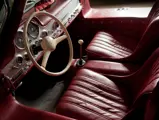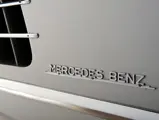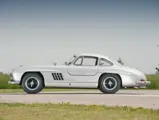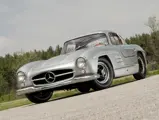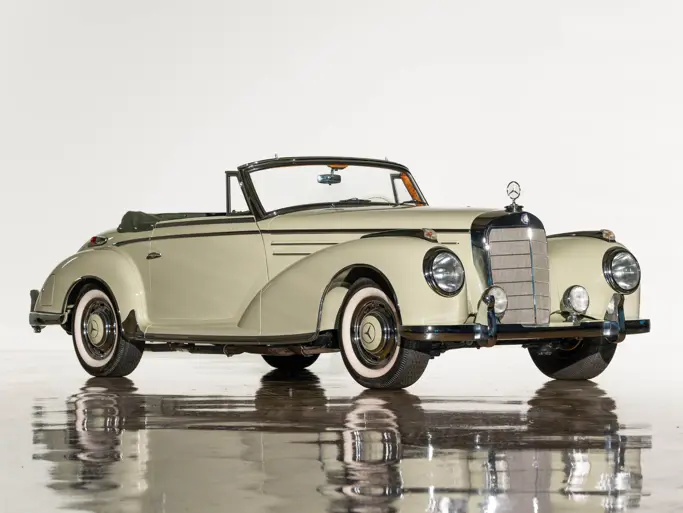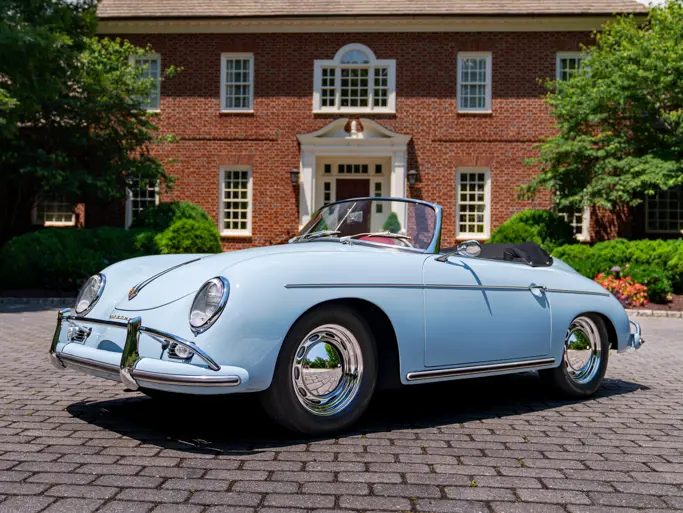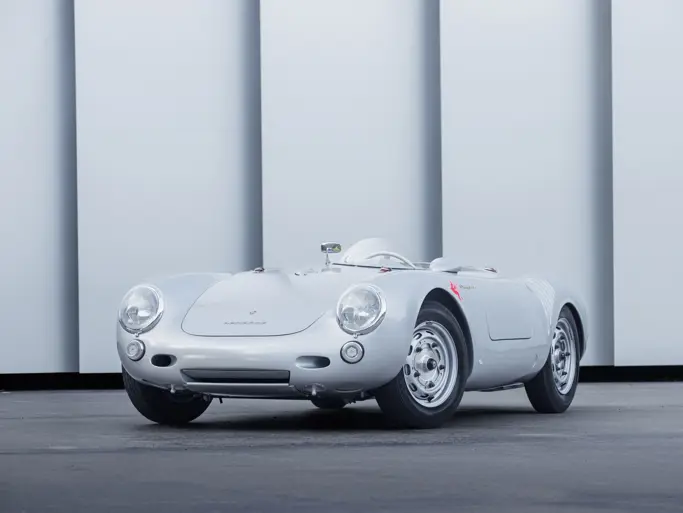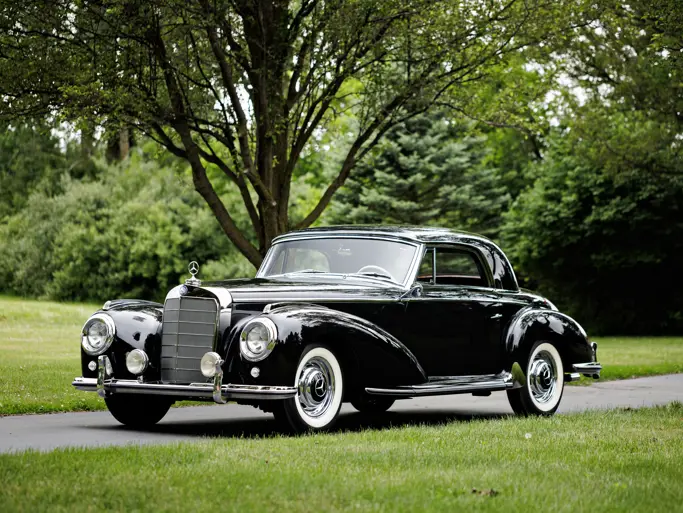St. John's 2011
1955 Mercedes-Benz 300SL Coupe
{{lr.item.text}}
$676,500 USD | Sold
 | Plymouth, Michigan
| Plymouth, Michigan
{{internetCurrentBid}}
{{internetTimeLeft}}

215 bhp, 2,996 cc overhead-camshaft inline six-cylinder engine, Bosch mechanical fuel-injection, four-speed manual transmission, independent front suspension with unequal-length A-arms, coil springs and anti-roll bar, independent rear suspension with high-pivot swing axles with radius arms and coil springs, and four-wheel hydraulic drum brakes. Wheelbase: 94.5"
- Special Order example delivered new with rare Rudge wheels
- Attractive color combination
- Legendary performance, handling and styling
As was the case with several of Europe’s most important sports cars, Porsche and Ferrari included, the importation of a road-going 300SL to the United States would not have been possible without Max Hoffman. In fact, in the case of the SL, Hoffman, who was appointed Mercedes-Benz importer for the US market in 1952, deserves much of the credit for the development of the production car. While attending a meeting of Daimler-Benz’s Board of Directors, he assured everyone in attendance of the salability of the current model lines but also expressed particular interest in a production version of the famed 300 SL racing car. Initial objections to the proposition were based on the belief that the SL’s development was carried out very quickly to meet Mercedes’ reentry into sports car racing.
Thankfully, the determined Hoffman prevailed, leaving Germany with an order for 1,000 SLs, half of which became the more affordable 190 variant. Subsequent months of engineering, refinement and testing produced a car of outstanding performance, class and presence.
Introduced in 1954 to thrilled crowds in New York, the Mercedes-Benz 300SL was essentially a supercar with a price tag well in excess of $7,000! Its popular success in the United States was undoubtedly due to the burgeoning American fascination with smaller, nimble European sports cars – an interest expressed by many GIs returning from World War II. Additionally, the 300SL capitalized on the company’s racing successes and benefited from the technological advancements available therein.
300, of course, represented the engine’s displacement of three liters, while SL denoted sport leicht (sport light). Initially introduced as a coupe, the legendary sports car was conceived as a high-performance street machine with a thinly veiled racing character. The gullwing doors became the car’s visual signature and solved the cabin-entry problems posed by the car’s light tubular frame. Additional styling cues included bulges over the wheel openings, two longitudinal hood bulges and distinctive egg crate-like grillwork on both front fenders, which alleviated excessive heat and noise inside the car. Aluminum was used extensively for the bodywork, particularly for the doors, hood, trunk lid and interior sheet metal. The rest of the car utilized steel bodywork, although 29 examples are known to have been produced with all-aluminum bodies. Compared to competitive sports cars of its time, the 300SL developed an immediate reputation, not only for performance but for exceptional build quality as well. Whereas comparable sports cars featured carburetors, solid rear axles and pushrod engines, the 300SL offered Bosch fuel injection, independent rear suspension and an overhead camshaft. The six-cylinder engine produced 215 brake horsepower and 210 pound-feet of torque and was mated to a four-speed, fully synchronized transmission. Such figures translated into 0-to-60 times of approximately eight seconds – a truly impressive feat in the mid-1950s.
The gullwing doors used on the racing version of the car were continued on the production car, as they were necessary to maintain the structural integrity of the space-frame construction. This novel approach to building a car was not without difficulties. Mercedes had gone all the way towards a theoretically perfect multi-tube space-frame structure where all the tubes were slim and absolutely straight and none had to withstand bending or torsional stresses of any nature. Taken to these extremes, this would deny access to the car altogether, so there were inevitable compromises needed to gain entrance to the passenger compartment. To ease the problem, the frame was very deep along the sills, and the doors were arranged to hinge along their top edge and open upwards in “gull-wing” fashion.
Hoffman’s original request of 1,000 cars was exceeded as production of the semi-hand-built car reached 1,400 units. The 300SL Coupe was discontinued after the 1957 model year. Today, it remains one of the most recognized and coveted of all sports cars ever built.
According to the Gullwing Register, 67 300SL Coupes were built by Daimler between August and December 1954 – roughly 12% of total production. These very early cars are particularly desirable and include the car we have the pleasure of offering here, which was shipped new to the Mercedes distributor in New York on December 30, 1954.
Finished in Medium Red, it was delivered new with the extremely desirable Rudge wheels, as confirmed by its listing in the Register of “Special Order.” Known owners in the same Register are Chester Flynn, Charles Kriesler (New York), Trent Lowney (San Francisco, California), Chris Borden (Palm Springs, California) and Michael Rogerson (Encino, California). According to Borden, the original engine was replaced by a factory spare unit. In fact, it was also reported that Dr. Werner Vogler raced the car in Hamburg, Germany, who it is believed was the prominent German Mercedes dealer who first opened his doors in 1927 and whose dealership network is now celebrating over 80 years of business.
In the intervening years, the car has been finished in metallic silver-grey, which is offset beautifully by the striking red leather upholstery and of course the very desirable and valuable Rudge wheels. The car remains very presentable and has recently been treated to an extensive service. Any cosmetic imperfections are only visible upon closer examination; the leather is devoid of rips or tears but shows natural signs of use, while the paint and brightwork are equally presentable with only small imperfections and, again, exhibit limited patina attributed to an older restoration and normal driving use.
The race inspired, fuel-injected three-liter puts out 215 horsepower. Coupled with the four-speed manual transmission, the performance potential is formidable. In 1955, no other vehicle came close to those speeds, and the 300SL was easily the fastest production automobile on Earth. Not only is the Mercedes a feat of engineering genius, its styling and design is revolutionary even to this day. This is a wonderful example in attractive colors and with factory Rudge wheels.
Please note that this car is titled by its engine number.



